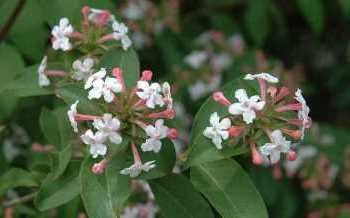Fragant abelia
(Zabelia tyaihyoni)

Description
Zabelia tyaihyonii (Synonym: Abelia mosanensis) known as the fragrant abelia, is a species of deciduous shrub in the honeysuckle family Caprifoliaceae. Growing up to 2 meters high and wide, it is hardier than many related species, surviving temperatures as low as −20 °C (−4 °F). The tubular blooms are pinkish-white and highly scented, appearing in late Spring. The glossy green leaves turn red in autumn before falling. Zabelia tyaihyonii is a popular garden shrub. The cultivar 'Korean Spring' (under the name Abelia mosanensis) has gained the Royal Horticultural Society's Award of Garden Merit. Abelia is a previously recognized genus that contained about 30 species and hybrids, placed in the honeysuckle family, Caprifoliaceae. Molecular phylogenetic studies showed that the genus was not monophyletic, and in 2013, Maarten Christenhusz proposed the merger of Abelia (excluding section Zabelia) into Linnaea, along with some other genera. Abelia section Zabelia was raised to the genus Zabelia. Species formerly placed in Abelia are shrubs from 1-6 m tall, native to eastern Asia (Japan west to the Himalaya) and southern North America (Mexico); the species from warm climates are evergreen, and colder climate species deciduous. The leaves are opposite or in whorls of three, ovate, glossy, dark green, 1.5–8 cm long, turning purplish-bronze to red in autumn in the deciduous species. The flowers appear in the upper leaf axils and stem ends, 1-8 together in a short cyme; they are pendulous, white to pink, bell-shaped with a five-lobed corolla, 1–5 cm long, and usually scented. Flowering continues over a long and continuous period from late spring to fall. Some of these species are cultivated as ornamental garden plants, and may still be described as Abelia in horticultural listings. A notable example is the hybrid Abelia × grandiflora (now Linnaea × grandiflora). The generic name commemorates Clarke Abel, a keen naturalist who accompanied Lord Amherst's unsuccessful embassy to China in 1816 as a surgeon, under the sponsorship of Sir Joseph Banks. All of Abel's seeds and plants were lost in a shipwreck on the homeward voyage, however; living plants of Abelia chinensis (now Linnaea chinensis) were first imported to England in 1844 by Robert Fortune. Some species placed in Abelia were transferred to Linnaea at various times from 1872 onwards, but these transfers were not accepted by most botanists.
Taxonomic tree:







